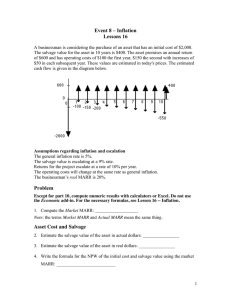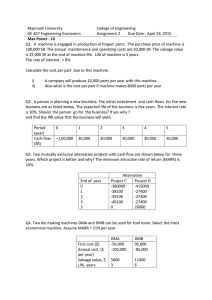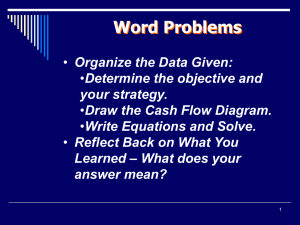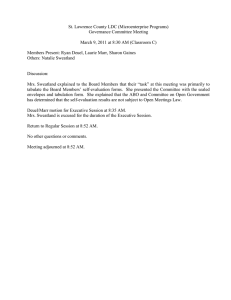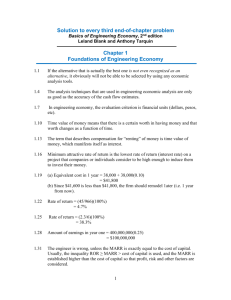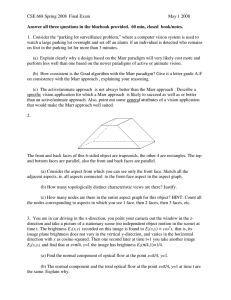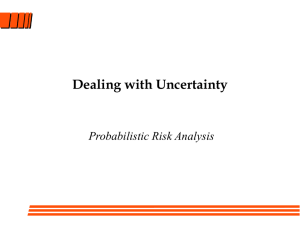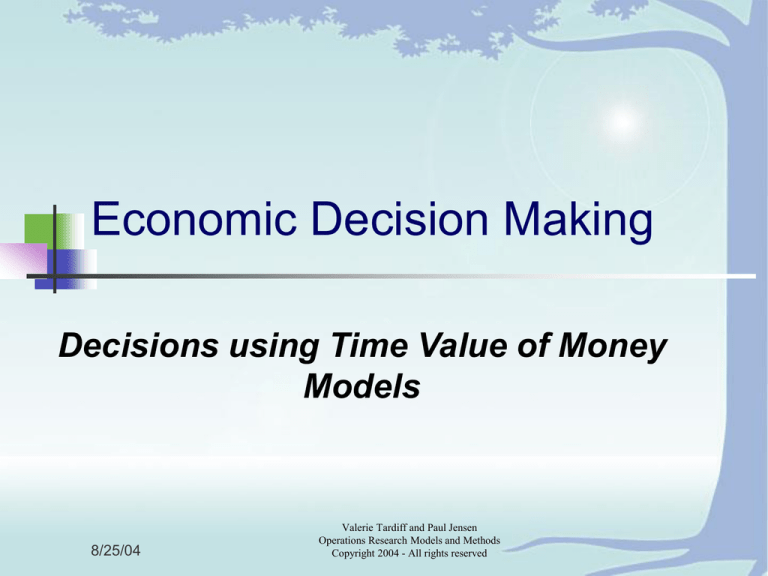
Economic Decision Making
Decisions using Time Value of Money
Models
8/25/04
Valerie Tardiff and Paul Jensen
Operations Research Models and Methods
Copyright 2004 - All rights reserved
Engineering Economic
Analysis
Recall the seven steps of
Engineering Economic Analysis
2
Why Do We Make
Investments?
Buy stock in return for dividends and a
higher stock price in the future.
Invest in a machine in return for reduced
operating costs or greater sales in the
future.
Buy a bond in return for interest payments
and the return of principal in the future.
We give up money now in the hopes of
receiving more money in the future.
How much return is enough?
3
Why Do We Borrow Money?
We borrow money to buy a $100,000
house in return for paying $300,000 over
the next 30 years.
We borrow $10,000 to buy a car and pay
an extra $2,000 in interest.
We buy a new set of clothes and put the
bill on our credit card.
We spend money now in return for paying
more money in the future.
How much are we willing to pay?
4
Example
Your brother borrows $200 from you.
He will pay back in monthly payments of
$14.44 for the next 16 months.
Is this an acceptable investment for you,
the lender (or investor)?
Is this an acceptable loan for your brother,
the borrower?
5
Cash FlowForfor
Lender
the investor
14.44
0
……
0
1
2
3
4
5
6
7
8
……
16
-200
6
Is this an acceptable
What is the total summed over all cash
investment?
flows?
-200 + $14.44 (16) = $31.04
Is this enough?
Say the lender requires a minimum return
of 1% per month. Does this investment
obtain the required return?
7
Choose
Selection
Procedure
a Minimum Acceptable Rate of Return (MARR) (for
the lender) or
Evaluate the Equivalent Value of the Cash Flow
using the MARR:
Compute the Net Present Worth (NPW),
compute the Future Worth (FW) , or
compute the Net Annual Worth (NAW).
If the NPW, FW or NAW is ≥ 0, accept the
investment or the loan.
Otherwise, accept the do-nothing alternative. In other
words, reject the investment or the loan.
8
The NPW as a function of
Recall our Example,
MARR
NPW = –200 + 14.44 (P/A, MARR, 16)
35
30
25
20
15
10
5
0
-5
-10
-15
Net Present Worth
MARR (Percent)
0
0.5
1
1.5
2
2.5
When MARR is 1%, NPW is > 0, so accept the investment.
9
Minimum Acceptable Rate of
Return (MARR)
In theory, the minimum acceptable
rate of return (MARR) is the interest
rate that could be received if the
funds were invested elsewhere.
It helps to think of it as the hurdle
rate.
10
MARR (cont’d)
In practice, it depends on much more than
the bank interest rate. It is determined by
top-management and depends on
the amount of money available for investment,
the source and cost of these funds,
the number of good projects available for
investment and their purpose,
the amount of risk associated with investment
opportunities and the cost of administering
investments, and
the type of organization.
How an organization determines its MARR
11
The
NetPresent
Present Worth
method, also
Net
Worth
called the Present Worth (PW), method
compares all cash flows only after they
have been measured at a common point in
time determined to be the present date.
To find the NPW as a function of i%, we
transform cash flow amounts to their
equivalent in the present and add them.
NPW = CF0 + CF1 (P/F, i,1) + CF2 (P/F, i,2) +
…. + CFN (P/F, i, N)
12
Cash Flow for the Borrower
200
For the borrower
0
0
1
2
3
4
5
6
7
…… 16
……
8
-14.44
13
Is this an acceptable loan?
What is the total summed over all cash
flows?
200 - $14.44 (16) = - $31.04
Is this reasonable?
Say the borrower wants a cost of
borrowing no more than 2%. Does this
loan cost more than the maximum
acceptable rate for borrowing?
Compute the NPW using the MARB. If it is
14
The NPW as a function of
Recall our example,
MARB
NPW = +200 - 14.44 (P/A, MARB, 16)
Net Present Worth
15
10
5
0
-5 0
-10
-15
-20
-25
-30
-35
MARB (Percent)
0.5
1
1.5
2
2.5
When MARB is 2%, NPW is > 0, so accept the loan.
15
Maximum Acceptable Rate
of Borrowing (MARB)
The maximum acceptable rate of
borrowing (MARB) is the interest rate
that would be paid if the funds were
borrowed elsewhere.
The interest rate charged by a bank
is often the MARB used.
16
Future Worth
The Future Worth (FW) method compares
all cash flows only after they have been
measured at a common point in time
determined to be the end of the analysis
period.
To find the FW as a function of i%, we
transform cash flow amounts to their
equivalent in the future and add them.
FW = CF0 (F/P,i,N) + CF1 (F/P,i,N-1)
+ CF2(F/P,i,N-2) + … + CFN-1 (F/P,i,1) + CFN
17
Net
Worth
The
Net Annual
Annual Worth
(NAW) method, also called
the Annual Worth (AW), method compares all
cash flows only after they have been transformed
into time-equivalent annuities.
To find the NAW as a function of i%, we transform
the cash flows over time as uniform payments
over the length of the project period.
NAW = NPW (A/P, i, N) = FW(A/F, i, N)
18
Equivalence
NPW, FW, and NAW all yield the same
decision since they are all the
representations of the same cash flows at
different points of time.
NAW = NPW (A/P, i, N)
FW = NPW (F/P, i, N)
where i = MARR for the investor
i = MARB for the borrower
19
Capital
Recovery
Cost
In most
engineering
situations,
the capital
cost has two components
I, the investment expended at time 0, and
S, the salvage value received at time N.
S
0
N
I
20
Capital Recovery Cost
Capital
Recovery (CR) Cost is the annual
(cont’d)
equivalent of the capital cost.
CR (i) = I (A/P, i, N) - S (A/F, i, N)
Other Formulas
CR (i) = (I -S) (A/P, i, N) + i S and
CR (i) = (I -S) (A/F, i, N) + i I
21
Your
company is planning to manufacture a
Example
new product. The product requires a machine
that the company does not now own. The cost
of the machine is $10,000, its life is 4 years,
and its salvage value (at the end of the 4th
year) is $1,000. With this machine, the new
profit from each product is $12. What annual
production makes the investment worthwhile?
The MARR is 10%.
22
Example (cont’d)
Find the capital recovery costs
I = $10,000
S = $1,000
MARR = 10%
Useful life N = 4
CR = I (A/P, MARR, N) - S (A/F, MARR, N)
= $10,000 (A/P,10%,4) - $1,000 (A/F,
10%, 4)
= $10,000 (0.3155) - $1,000 (0.2155)
= $3,155-$215.50 = $2939.5
23
Example (cont’d)
Using the shortcuts,we get
CR = (I-S) (A/P,10%,4) + (10%) S
= $9,000 (0.3155) + (0.1)$1,000
= $2,839.5 + $100 = $2939.5
CR = (I-S) (A/F,10%,4) + (10%) I
= $9,000 (0.2155) + (0.1)$10,000
= $1,939.5 + $1,000 = $2939.5
24
Example (cont’d)
Capital recovery costs must equal or
exceed revenues to be profitable.
CR = $2939.5 = $12x where x is the
number of products produced per year.
Solving for x, we get x >= 250 units.
25

